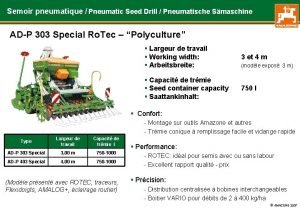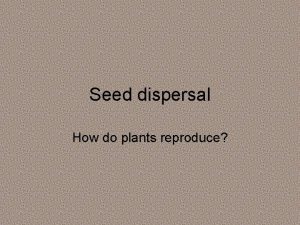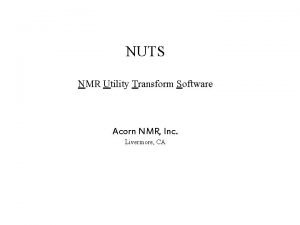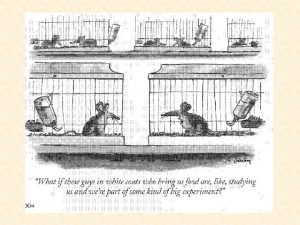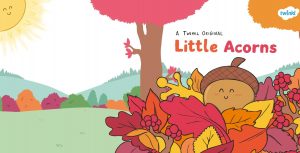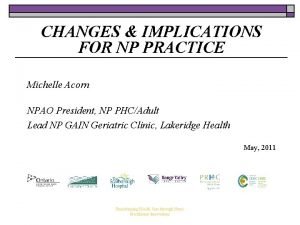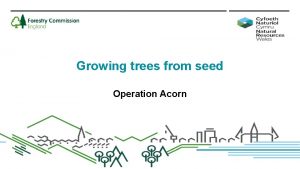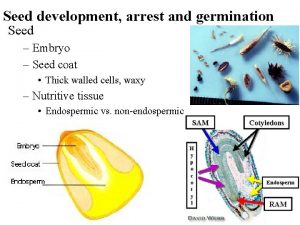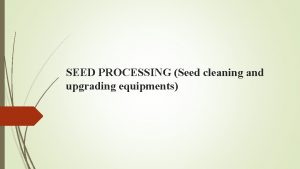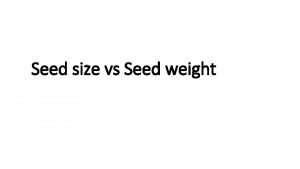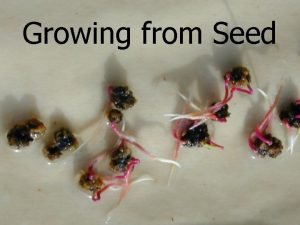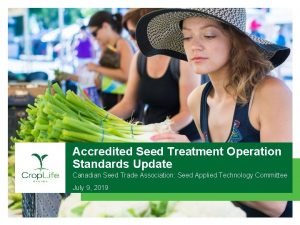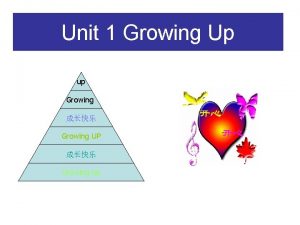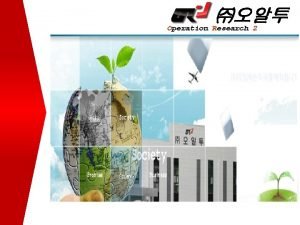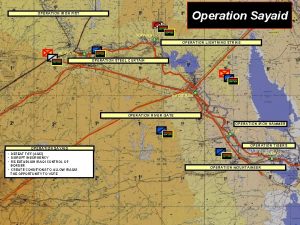Growing trees from seed Operation Acorn This Power
























- Slides: 24

Growing trees from seed Operation Acorn

This Power. Point presentation explains: - Why Wales needs local seed to grow the best possible trees for it’s forests - What Natural Resources Wales is doing to ensure it’s trees and woodlands are fit for the future - What happens behind the scenes at Delamere, Forestry England tree nursery to grow acorns on to become oak trees. - What happens to the trees once they are ready to leave the tree nursery and return to Welsh forests.

Local provenance trees What are local provenance trees? The term provenance describes the geographic location of a stand of trees from where seed was collected. For trees and shrubs, Britain is divided into four regions of provenance. Each area of provenance has climatic similarity (the landscape, weather and temperature within the area is roughly the same). Wales sits in the ‘ 30’ region of provenance. The regions of provenance have been sub-divided to produce 24 local seed zones which have similar ecological and climate characteristics. Question – did your education group take part in NRW’s Acorn Antics campaign? What seed zone were your acorns collected from? https: //bit. ly/2 DZ 6 h. Y 2 - link to the seed zone map

Why plant native, local provenance trees? • The planting of native, local provenance trees ensures that their genetic makeup of the trees being planted have has become adapted over time to the range of climatic and soil conditions in the place in which they are growing - temperature fluctuations, rainfall levels and wind speeds. • With increasing concern about pests and diseases in trees and the onset of climate change woodland managers are looking to ensure that the trees they plant are as resilient (resistant) as possible to outbreaks of disease and are best adapted to changing climatic conditions. Planting native, local provenance trees gives the best chance of ensuring this. • Importing trees from abroad increases biosecurity risks (the risk of the spread of infectious diseases) – for example, the tree fungus Ash Dieback (Chalara fraxinea) was brought into the UK on trees shipped over from Europe.

Looking to the future In Wales, our forests and woodlands have traditionally been dominated by a very limited range of tree species with many sites (when being managed for timber production) being planted with a single species). This is a risky strategy in light of future predicted climatic change, and a likely increase in the incidence of pests and diseases. We recognise that by increasing the diversity of the tree species we plant and sourcing seed from an increased number of well dispersed sources, we can increase the resilience of Welsh woodlands to the impacts of climate change and pests and diseases.

Acorn Antics project Projects such as our ‘Acorn Antics’ campaign, which we run every autumn asks learners big and small to get outside and collect acorns on our behalf to help us meet the future challenges for our trees and woodlands face. To learn more about NRW’s Acorn Antics campaign please visit the webpage Map showing the locations of the 2018 Acorn Antics collections

Autumn – Operation acorn begins Acorns are highly perishable. From the moment they fall to the ground to getting them planted in the ground it’s a race against time.

Before they can be planted… Once received, all the Acorn Antics acorns are taken to the Forestry Commission England’s Delamere Tree Nursery in Cheshire. On arrival the sacks are checked and weighed.

Assessing acorn quality Discuss - Why have these acorns been cut in half? Question - Of the acorns pictured, which do you think are of the highest quality and most ‘viable’? Explain your answer.

The race to germinate Once all the acorns have been received and checked a germination test is undertaken. Question - What is a germination test? A germination test estimates the percentage of acorns within a sample that are capable of germinating. Question - Why do a germination test? Video of an acorn germinating, filmed over 8 months - 1. 26 minutes https: //www. youtube. com/watch? v=ijm. MA 9 hlo 00 Knowing the germination rate of a particular seed is key to understanding how well that seed will grow once sown.

Time vs average acorn germination rate Acorns ripen on tree and begin to drop Acorns collected Acorns sown in the ground at the nursery Question – what impact does time have on the germination % rate of acorns? 100 90 Acorn germination % 80 70 60 What is the germination % rate when the acorns: 50 40 30 20 10 0 End of Beginning Mid September of October End of October Beginning Mid End of of November of December November December Time - Drop from the tree? - Are collected? - Sown in the ground at the nursery?

Keeping deterioration at bay Question – What factors might speed up the deterioration of an acorn and reduce it’s chances of successfully germinating?

Acorn rates of germination • The average number of viable acorns is: - 250 per kg. for sessile oak - 220 per kg. for pedunculate oak • The approximate number of oak trees that will successfully germinate per kg. of acorns is 80 -120 for both sessile and pedunculate. Question – If 250 sessile acorns are planted and 120 acorns successfully germinate, what’s the acorn germination rate as a %?

Winter - Storing acorns Once they have been checked, acorns are sorted and tipped onto trays and stored on pallets. When it’s been confirmed that all the acorns have been delivered to the nursery, the trays are emptied and acorns grouped according to their species and region of provenance in the coldstore.

Preparing to sow Once all collections have been received the acorns are mechanically sown (by a machine) into seed beds as soon as possible to reduce the rate of acorn deterioration – usually end of November. Video of the acorns being mechanically sown – 35 seconds https: //youtu. be/Lt-Fr. VBh. E_Y

Seed beds Question – why are the seed beds netted?

Spring - Nurturing young saplings

Summer - Undercutting is completed once the saplings have emerged and new growth has had a chance to establish. Undercutting involves drawing a horizontal mounted blade on a specialist machine through the soil at a certain depth below a bed of young trees to sever the deeper tree roots. Undercutting young conifer trees

Dormancy Undercutting is performed whilst plants are dormant. Question - What is dormancy in trees? Dormancy - is a period in a tree’s life cycle when growth and development are temporarily stopped. The dropping of leaves indicates that trees are becoming dormant. Trees enter the dormant or ‘resting’ season based on the decrease in temperature and the decrease of daylight received as autumn retreats into winter. Like hibernating animals, trees fill themselves with food before winter, using it up slowly during the cold dormant months.

Fibrous vs tap root systems Root system of a plant that has been undercut Root system of a plant that hasn’t been undercut Question – what are the observable differences between the two root systems? Question – which root system do you think has developed as a result of being undercut? www. thedailygarden. us/garden-word-of-the-day/roots Question – Why do you think a fibrous tree root system is more favourable to a tap root system in the tree nursery?

Autumn/Winter - Lifting and planting During the autumn the trees are counted and their heights measured. As the trees become dormant in the late autumn/winter they are ready to be mechanically lifted (dug up by machine). To check whether or not they are fully dormant the tree nursery carries out a ‘Root Electrolyte test’. Only when the checks show that the trees have reached a certain level of dormancy, can they be lifted. They are then graded (best to worst), counted into bags and are ready to go to the forest for planting. Delivered by road, once the trees have been received by Natural Resources Wales they are planted back in the seed zone from where they were collected as an acorn. Grading the trees at the tree nursery

Winter/Spring - Planting out A race against time and the elements, planting will have to be completed by the spring and the winter’s heavy rain, frost and snow will all hamper the tree planting teams. Whether they are planted by mechanical or human means, a small, deep hole is made in the ground. The young oak trees are carefully placed in the hole, all the roots are carefully immersed before being covered with soil. As the trees mature, we monitor them for up to five years after they’ve been planted to ensure they are surviving. In some areas, weeding may be necessary to ensure the trees survive into the future.

Conclusion With high rates of deterioration it takes a lot of time and effort to successfully grow acorns onto young oak trees. Throughout the year various tasks need to be undertaken to give the collected acorns the best chance of survival. There is never a quiet time in the tree nursery. Due to their high value for wildlife, the environment and people – each acorn is valuable and worth the effort.

The end
 Acorn seed dispersal
Acorn seed dispersal Hooked seed dispersal
Hooked seed dispersal The real lesson 21
The real lesson 21 Acorn people ron jones
Acorn people ron jones Acorn nmr
Acorn nmr Acorn acadia
Acorn acadia Acorn risc machine
Acorn risc machine Acorn imperatives
Acorn imperatives Acorn 32-bit
Acorn 32-bit Acorn nmr
Acorn nmr College board acorn
College board acorn Acorn calf syndrome
Acorn calf syndrome The acorn grew slowly
The acorn grew slowly Acorn squirrel crow coyote energy pyramid
Acorn squirrel crow coyote energy pyramid Non vertebrate
Non vertebrate Michelle acorn
Michelle acorn Acorn health partnership
Acorn health partnership Types of growing media
Types of growing media Romaine lettuce growing stages pictures
Romaine lettuce growing stages pictures Growing perpetuity formula
Growing perpetuity formula Growing up in the indus valley
Growing up in the indus valley Sugar crystals experiment conclusion
Sugar crystals experiment conclusion Usda zones hawaii
Usda zones hawaii Pv of a growing perpetuity
Pv of a growing perpetuity Perpetuity formula
Perpetuity formula
